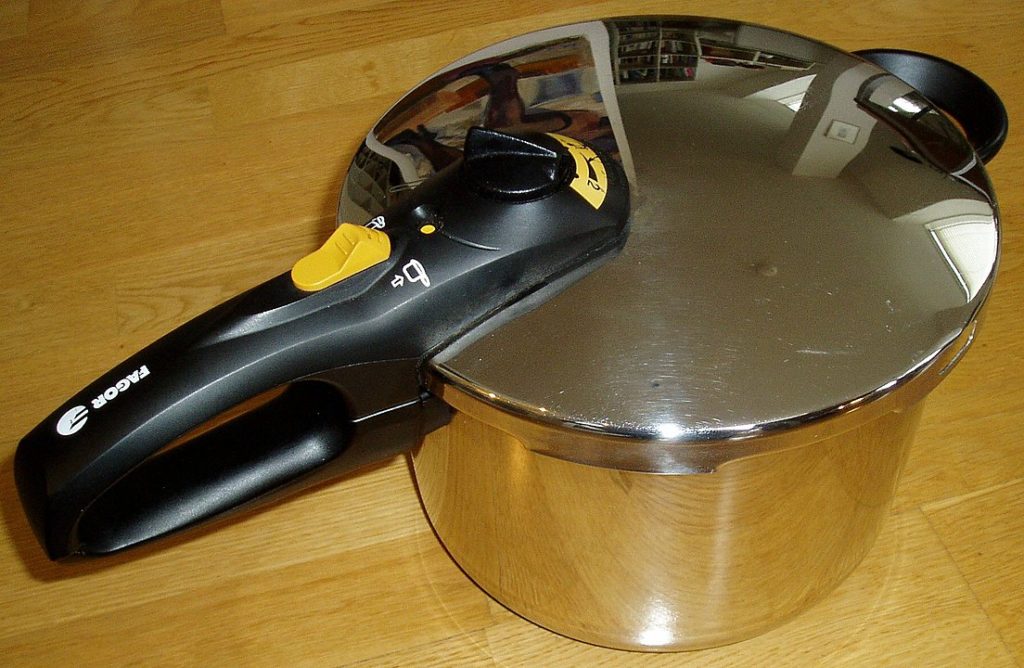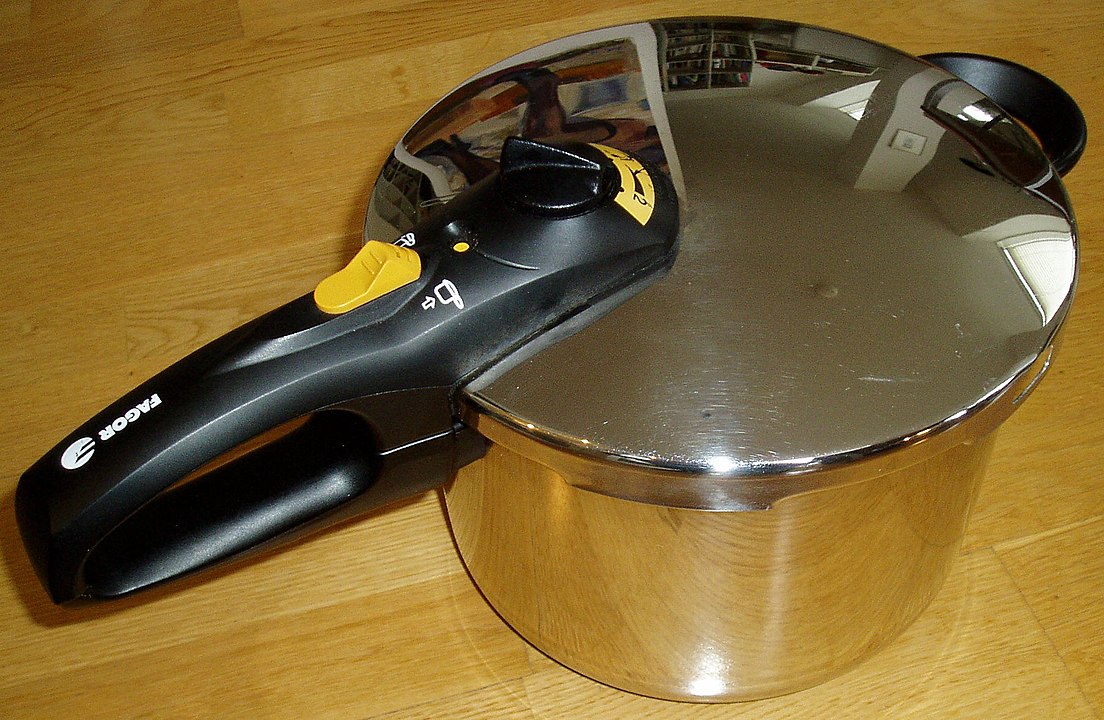
#398 How does a pressure cooker work?
How does a pressure cooker work? By using high pressure to raise the boiling point of the water.
Pressure cookers were invented in 1679 by a French physicist. He was trying to find a way to cook food faster. Cast iron pressure cookers were made in Germany in 1864. Pressure cookers improved through the early 20th century, and they became very popular during the 1940s and 50s. They can cook food about 30% faster than using an oven or a stovetop pan. However, their popularity faded during the 1970s with the increasing availability of microwaves. These days, most households will probably have a pressure cooker because they can do things that microwaves can’t. So, why can a pressure cooker cook food so quickly?
All liquids have a boiling point, which is the point at which their vapor pressure becomes equal to the pressure of the gas above them. As a liquid is heated and more energy is imparted to the molecules, they start to move more and some of them change into their gas state. These molecules are still inside the liquid, and they will form bubbles. The bubbles rise to the surface and release the gas into the air. Not all of the liquid molecules have enough energy to become a gas, so the gas above the liquid is not entirely gas, it is a vapor. A vapor is a substance that is a mixture of liquid and gas. When the boiling point is reached, the molecules in the liquid have enough energy and enough pressure to equal the pressure of the atmosphere above them and they transition into their gaseous state completely and escape the liquid.
The boiling temperature of water is 100°C at sea level. Different liquids have different boiling points depending on the strength of the bonds between the particles and the mass of the particles. Helium is the lightest and weakest bonded substance, and it has a boiling point of -269°C. Tungsten has very heavy particles that are very strongly bonded and it has a boiling point of 5660°C. Incidentally, the Celsius scale was created to make an easier system than Fahrenheit. It is based on water freezing at 0°C and boiling at 100°C.
Water boils at 100°C at sea level, but because the boiling point is reached when the vapor pressure equals the atmospheric pressure, if you change the atmospheric pressure, you can change the boiling point. The boiling point of water changes with altitude because as we go higher the atmospheric pressure decreases. At 305 m above sea level (ASL), the boiling point of water is reached at 99°C. At 1067 m ASL, it is 96°C. At the top of Mt. Everest, which is 8848 m, the boiling point of water is 68°C. That means, you only need to heat water to 68°C for it to boil.
Now, the reverse is also true. If you increase the atmospheric pressure by going deeper, the boiling point of water will increase. If you could go 1000 m under the sea and boil water, it would reach its boiling point at 103°C. If you were able to boil water at the bottom of the Mariana Trench, the deepest point on Earth, it would boil at 493°C. That means you would have to be able to get the water to a temperature of 493°C before it could overcome the pressure of the atmosphere pressing down on it and turn in to a gas.
So, how does a pressure cooker work? By using the knowledge that the boiling point of water changes at different atmospheric pressures. A pressure cooker consists of a metal, usually stainless steel, saucepan that has a lid that locks on. Inside the lid is a rubber seal that makes the cooker airtight. There is a release valve on the top of the pressure cooker lid.
Whatever is going to be cooked is placed in the cooker and about two cups of water are added. Less water is needed than with a stovetop pan because not much of the water will evaporate. The lid is locked on securely and the heat is switched on. Inside the pressure cooker, the atmosphere is the same as outside the pressure cooker. The heat is transferred to the water molecules and as they pick up more energy they start to move more. Some of the water molecules escape the liquid and become steam above the water. However, there is no where for them to escape to because the pressure cooker is airtight. As more water molecules become steam, the pressure inside the pressure cooker starts to increase. Very quickly it reaches 15 psi (pounds per square inch). At that atmospheric pressure, water has to reach 121.1°C to reach its boiling point. This means that the water can take more heat energy without boiling and can become far hotter than it would in a regular pan. This is why a pressure cooker can cook food so much faster. All of the extra heat energy is imparted to the things being cooked.
Why don’t pressure cookers explode? Well, some of them used to. Now, though, they have a lot of safety valves. The valve on the top is designed to release the steam periodically to make sure that the pressure stays at 15 psi. When the cooking is finished, the valve can be used to release all of the steam. There are three ways of releasing the steam. Slow release, which slowly releases the steam out of the valve. This means the cooker will continue cooking for longer. Quick release, which means all of the steam is released very quickly. This lowers the pressure and the hot water in the pressure cooker will boil like crazy. Then there is cold water release, which means the whole pressure cooker is run under cold water to bring the temperature down and turn the steam back to liquid water.
As a final note, because the boiling temperature at the top of Everest is so low, it is difficult to cook anything. Some mountaineers take pressure cookers so that they can cook their food.
So, how does a pressure cooker work? By increasing the pressure inside so that the water boils at a higher temperature. And this is what I learned today.
Sources
https://www.thespruceeats.com/boiling-points-of-water-1328760
https://www.seriouseats.com/how-pressure-cookers-work
https://www.exploratorium.edu/food/pressure-cooking
https://en.wikipedia.org/wiki/Pressure_cooking


[…] When the pressure in the vapor is the same as the atmospheric pressure, the liquid starts to boil. However, there is a point before that where the vapor builds up until there are enough molecules […]
[…] case of the corn kernel is very hard and does not let water in or out. The kernel acts like a pressure cooker. The steam starts to take up space inside the kernel and increases the pressure, which also […]